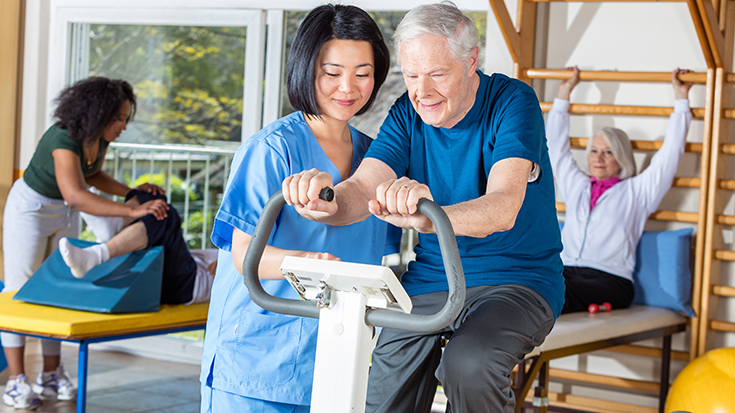
Pulmonary Rehabilitation Week is March 11 – 17, and that means now is a great time to learn more about this area of respiratory therapy and what it can mean for chronic lung disease patients.
AARC member Kitty Collins, BHS, RRT, has been working in PR for decades now and explains why patients need this level of care.
“Patients with chronic lung disease are often not given the education and support they need when in the hospital and or even in their physician’s office,” said Collins, who works as a senior respiratory therapist in the pulmonary rehabilitation (PR) program at St. David’s Medical Center in Austin, TX.
“Even with education in one of these settings, patients may need additional training and reinforcement to completely understand what they have learned,” Collins said.
They find it in pulmonary rehab.
Conquering fear
PR programs typically meet two or three times a week over a six to 10 week period, ensuring respiratory therapists and other clinicians have ample time to provide their patients with the intense education they need to manage their conditions at home and stay out of the acute care hospital.
Getting active and staying active is key.
“Exercise is one of the primary non-medical treatments to help improve their quality of life and decrease shortness of breath. The majority of patients are unable to take that first step because of fear that they will not be able to control their shortness of breath,” Collins said.
Pulmonary rehab offers them the chance to exercise in a safe and nurturing environment.
“As they progress in pulmonary rehab they realize that they have control through breathing techniques, energy conservation, medication management, and assessing their oxygen needs and titrating appropriately with activity and rest,” Collins said.
New lease on life
Patients who go through these programs often come out with a new lease on life and Collins says seeing them progressively regain lost abilities makes this one of the most fulfilling specialties in the profession.
“Being able to see someone do something they didn’t think they would ever do again, such as traveling, going to a grandchild’s baseball game, going to a movie, or swimming with oxygen is one of the best things about working in pulmonary rehab,” she said. “In pulmonary rehab we give people hope for a more normal and functional life.”
These resources can help
Want to learn more about this rewarding area of respiratory care? The AARC has a number of resources for those thinking about getting into the area, as well as those like Collins who have been long-time therapists in this setting. Resources include our new 12.0 CRCE Pulmonary Rehabilitation Certificate Course, offered through a partnership with the American Association of Cardiovascular and Pulmonary Rehabilitation.
The AARC also has a new Supplemental Oxygen Information Brochure, available in a pack of 25, that PR programs can hand out to their patients who are new to oxygen or need help understanding how it fits into their plan of care. (It’s free!)
Other resources include:
- Course
- Pulmonary Disease Educator Course: Pulmonary disease management information aimed at helping therapists improve care and quality of life for patients with conditions ranging from asthma and COPD to cystic fibrosis, interstitial lung disease, lung cancer, and pulmonary hypertension. 14.5 CRCEs.
- Toolkit
- Pulmonary Rehabilitation Program Toolkit: Guidance designed to help PR programs accurately report their charges to Medicare.
- Video
- Current Topics Program 1 – Pulmonary Rehabilitation: The Year in Review: Brian W. Carlin, MD, MAACVPR, presents his review of the most recently published studies in the field of pulmonary rehabilitation. Strategies on how to implement these research findings into the everyday practice of pulmonary rehabilitation will also be discussed.
- Additional Tools
- Position Statement on Pulmonary Rehabilitation: A short and to-the-point overview of what a PR program should entail that can be useful to those developing a new program or upgrading an existing one.
- Post Acute Care Section: A Specialty Section within the AARC featuring targeted newsletters and a dedicated discussion list on AARConnect.
Win-win for all
The drive to reduce both admissions and readmissions among chronic lung disease patients is only likely to intensify as the nation continues to grapple with rising health care costs.
Pulmonary rehabilitation programs that improve the health, fitness, and quality of life of these patients are a win-win for everyone involved.